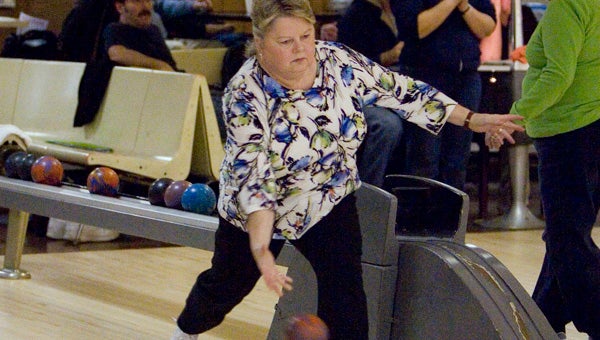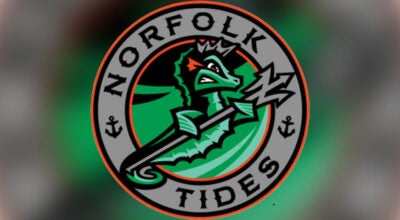A night in the alleys
Published 8:03 pm Saturday, March 9, 2013

Brenda Gregory bowls this past Tuesday night during a regular season match-up in the Suffolk Mixed Duckpin Bowling League at the Victory Lanes Bowling Center in Portsmouth. Gregory is the president of the league and owns the top average score per game among women in the league (111.43).
Duckpins offer big challenge for Suffolk league
The clatter of short, squat pins sent flying by softball-sized bowling balls filled the Victory Lanes Bowling Center in Portsmouth on a recent Tuesday, when the Suffolk Mixed Duckpin Bowling League took to the lanes.
A similar sight in the early 1900s led two Baltimore alley owners to compare the pins to a “flock of flying ducks.”
Duckpin bowling has several key differences from the more widespread “10-pin” bowling, and while its true origin is in dispute, the unique sport endures on Victory Boulevard, where several leagues operate, including the one from Suffolk.
League secretary Carolyn Ricks of Suffolk explained a popular reason why the players in their association prefer throwing the smaller balls at pins — still 10 in number, actually — that are shorter and more spread out.
“It’s more challenging,” she said.
“I have friends who say, ‘Oh, little balls? Nothing to it,’” league president Brenda Gregory said. “I say, ‘Come on over and try.’”
“You can throw the 10-pin ball down the middle and hit eight,” Tommy Ricks said. “Here you might chop right through and get two.”
“You can’t carry an average as high as 10-pin, and there’s never been a perfect game bowled in it,” Carolyn Ricks said.
A perfect game would be a score of 300, just like in 10-pin bowling. While the best 10-pin bowlers average in the upper 200s, however, Victory Lanes manager Don Ferguson said most elite duckpin bowlers average about 155.
To account for the added difficulty, one allowance made for bowlers is having three throws per turn. If all 10 pins are knocked down on the third try, however, it only counts as 10 points. Spares must be achieved on the second throw.
Some members of the Suffolk league alluded to another reason that they found duckpin bowling to be preferable to 10-pin.
“The other ball is heavy,” Connie Insley said. “This one’s not.”
“For me, I broke my wrist several years ago, and I can’t do three games in 10-pin any more, because the balls are too heavy,” Carolyn Ricks said.
A duckpin bowling ball weighs a little less than five pounds and is slightly larger than a softball.
Victory Lanes is an exclusively duckpin bowling alley, one of the few left. The bowlers competing there are zealous for the sport, but they realize it is becoming scarce.
“It’s been on the decline over the years, a slow decline,” league reporter Ron Sobel said. “There’s only like 47 (duckpin bowling alleys) throughout the U.S. now.”
Most of them are concentrated on the East Coast.
Ferguson offered a reason for the fall-off in popularity.
“(With) 10-pins, the scoring is easy,” he said. “Everybody bowls 300. This is a lot harder. Scores are not as high.”
Sobel noted the high-tech trappings of 10-pin when he said that the demographics of the Suffolk league tends to skew older.
“I think the younger ones are more attracted to the 10-pins because of the fancy lighting and stuff like that,” he said.
The Suffolk league has also seen a recent drop in membership, with only 27 members this season (12 from Suffolk), losing five three-player teams from last year. Carolyn Ricks offered a reason.
“I think a lot of it (is) finances,” she said. “People just couldn’t afford to pay the extra money to bowl every week, and once you commit, you’re committed — you have to pay whether you bowl or not.”
Still, among those who love to play, there is no fear of making impressive commitments.
Insley, who said she has bowled for 50 years now, travels each week with her husband, Kenny, to Portsmouth from Salvo, N.C., for the opportunity. The trip takes about two hours and 10 minutes, each way.
Herb Burd and his wife, Mona, both bowl and travel an hour and a half from Grandy, N.C.
League members described another major appeal.
Frank Larkin said he likes duckpin bowling for “just the camaraderie, just people, (to) get out of the house, do something, get a little exercise, something you enjoy.”
“It’s almost like a family,” Sobel said. “I’ve been here 15 years now, my wife’s been here about six or seven, and you see the same faces every week and you get to know people.”
In some cases, it literally is family. Jenny Holleman of Suffolk plays on a team with her brother Freddie Asbell and competes at times with her sister, Connie Insley, and her sister-in-law, Linda Asbell. Holleman also has a cousin, Billy Walsh, who plays on a team with Carolyn Ricks and Sobel’s wife, Faye.
“It makes it nice when you’re family and you’re not on the same team,” Holleman said. “It’s more competitive, and we egg each other on. We do a lot of kidding around.”
Another fact that could help keep duckpin bowling alive is its appeal to all ages. Faye Sobel describes a recent trip to Victory Lanes with her grandchildren, who she said “had a ball.”
“The whole place was full of parents and their children,” she said. “It was really nice, because you can’t find anything besides Chuck E. Cheese and the Bounce House.”
Those interested in joining the Suffolk league should call Brenda Gregory at 485-1007 or Ron Sobel at 539-6234.




